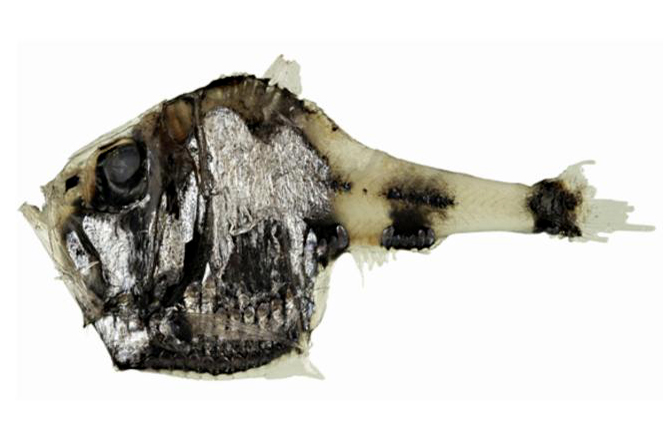Halfnaked Hatchetfish, Argyropelecus hemigymnus Cocco 1829
Other Names: Half-naked Hatchetfish, Half-naked Hatchet-fish

Halfnaked Hatchetfish, Argyropelecus hemigymnus. Source: Australian National Fish Collection, CSIRO. License: CC BY Attribution-Noncommercial
Summary:
Adult Halfnaked Hatchetfish undertake daily vertical migrations, rising in the water column at dusk to feed on copepods and small fishes in shallower mesopelagic and epipelagic waters.
Cite this page as:
Dianne J. Bray, Argyropelecus hemigymnus in Fishes of Australia, accessed 02 Jul 2025, https://fishesofaustralia.net.au/Home/species/3940
Halfnaked Hatchetfish, Argyropelecus hemigymnus Cocco 1829
More Info
|
Distribution |
A bathypelagic species, found at depths of up to 2,400 m. Usually occurs at 200-700 m during the day - concentrating at 350-550 m. At night, found at 100-650 m, preferring 150-380 m. Adults make daily vertical migrations to feed in shallower waters at night. |
|
Feeding |
Adults undertake daily vertical migrations in the water column, rising at dusk to feed on copepods and small fishes in shallower waters. |
|
Biology |
The photophores of Argyropelecus are thought to luminesce continuously (Clarke, 1963), with the intensity of the light produced being rapidly adjusted and modulated to match that of the background twilight. Females spawn planktonic eggs multiple times during a season. |
|
Author |
Dianne J. Bray |
Halfnaked Hatchetfish, Argyropelecus hemigymnus Cocco 1829
References
Baguet, F. & Marechal, G. (1976). Bioluminescence of bathypelagic fish from the strait of Messina. Comp. Biochem. Physiol. 53C: 75-82.
Baguet, F. & Marechal, G. (1978). The stimulation of isolated photophores (Argyropelecus) by epinephrine and norepinephrine. Comp. Biochem. Physiol. 60C: 137-143.
Baguet, F., Christophe, B. & Marechal, G. (1980). Luminescence of Argyropelecus photophores electrically stimulated. Comp. Biochem. Physiol. 67A: 375-381.
Clarke, W.D. (1963). Function of bioluminescence in mesopelagic organisms. Nature 198: 1244-1246.
Gjøsaeter, J. & Kawaguchi, K. 1980. A review of the world resources of mesopelagic fish. FAO Fisheries Technical Paper No. 193. Food and Agriculture Organization of the United Nations (FAO).
Harold, A.S. 2010. Argyropelecus hemigymnus. In: IUCN 2014. IUCN Red List of Threatened Species. Version 2014.1.
Hopkins, T.L., Sutton, T.T. &Lancraft, T.M. 1996. The trophic structure and predation impact of a low latitude midwater fish assemblage. Progress in Oceanography 38: 205-239.





